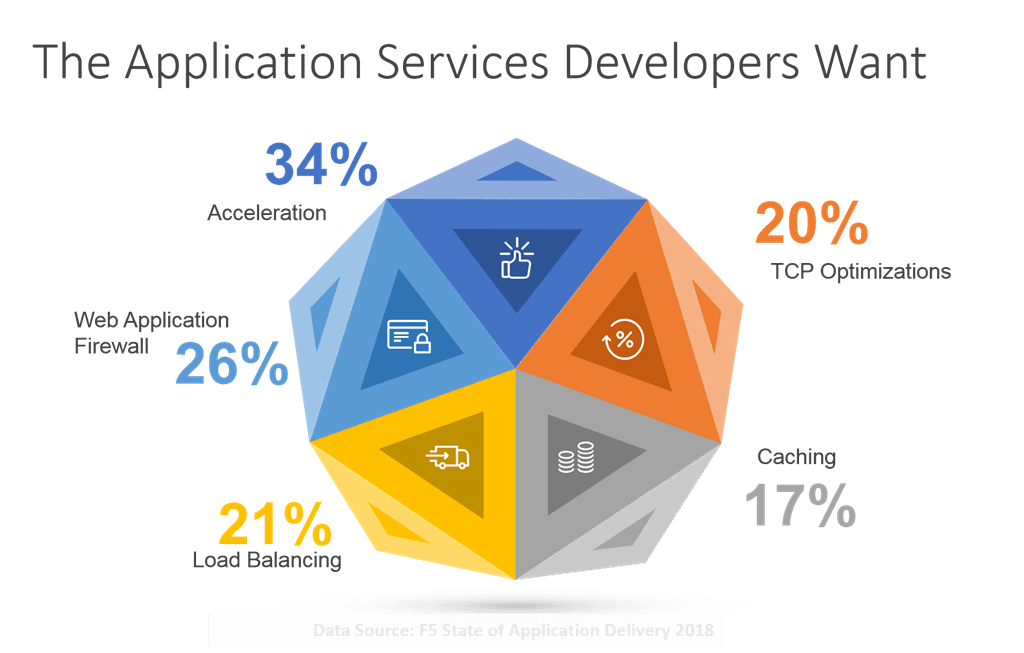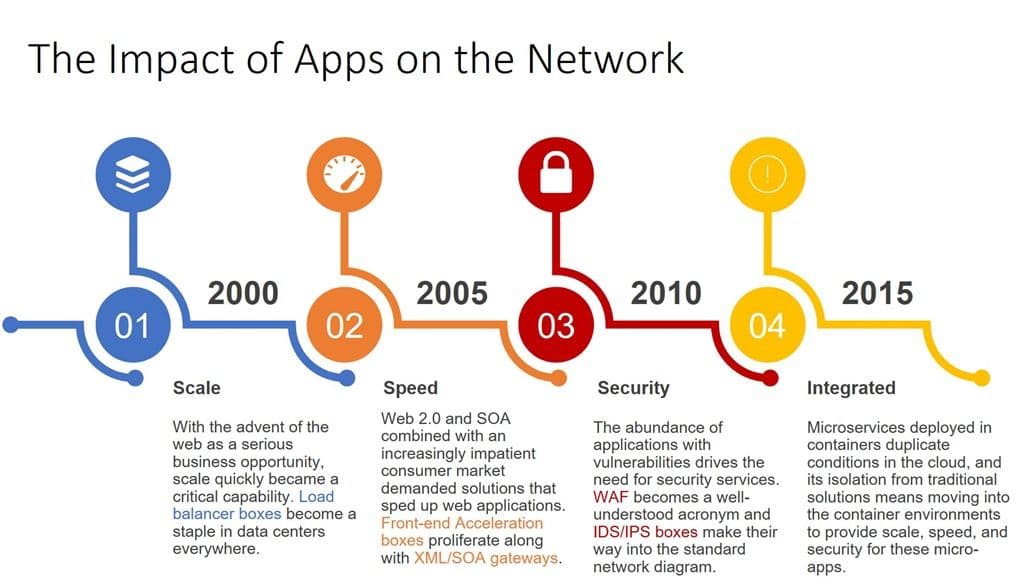Today, one of the most frequently heard questions in the halls of an infrastructure provider is how to explain the value of that infrastructure to the developer community. Trouble is, most of the benefits of infrastructure are garnered after delivery to production. None of these really provide value directly to the developer, at least not in a meaningful way that impacts their daily routine.
The extra-development benefits are something of which developers are certainly aware. In our 2018 State of Application Delivery we had a small percentage of developers represented. But that percentage spoke loudly on the topic of the application services they wanted to deploy. Some of those application services – load balancing, caching, and acceleration – are just as often deployed as part of the application itself as they are as infrastructure. TCP optimizations and WAF are almost always infrastructure services, deployed up stream (in the data path) in front of applications (whether monolith or microservices).

There’s value in all these application services. Reduction of risk, improved performance, scalability. But these are application and business benefits; they benefit developers post-delivery of the application to production. It’s hard to find – let alone articulate – benefits of infrastructure pre-delivery, i.e. as part of the development lifecycle.
But as we continue to embrace containers and microservices, the value in infrastructure pre- and post-delivery becomes more obvious.
Like most emerging technologies, the early days of a new application architecture bring with it very little infrastructure. It might be surprising for developers to learn that application architecture significantly shapes the application services infrastructure. From the move to three-tier, web-based apps came scalability (load balancing). From the adoption of Web 2.0 with its responsive presentation layer came front-end acceleration infrastructure. With the advent of mobile and increasing digitization of every industry we saw infrastructure react with security services like WAF, DDoS and bot defense.

So what we see happening right now is developers are codifying infrastructure service capabilities in their applications. Developers are putting into code what has traditionally been the responsibility of upstream services. Retries from load balancers. mTLS from the platforms or proxies. Access control to restrict communication to legitimate clients.
These are infrastructure responsibilities that, because of the nascent nature of container frameworks and the rapid adoption rates, have been assumed by developers.
But as has always been the case, that’s changing. Just as previous app architectures have driven responses in the network infrastructure, so are containers and microservices. Only this time the changes aren’t coming in the form of a new box. What’s happening now is the move to integrate the application services developers need into the container environment. That’s where service mesh comes in and offers up real, quantifiable value directly for developers.
As explained by Andrew Jenkins, Lead Architect at Aspen Mesh in an interview with Linux.com:
“It’s remarkable how easy it is to start making a web service today. You can fit the code in a tweet. This isn’t a real web service, though. To make it resilient and scalable you need to add some stuff to the data plane of the app. It needs to do TLS, and it needs to retry failures, and it needs to only accept requests from this service but not that one, and it needs to check the user’s authentication, and so on. A service mesh can help you get that data plane functionality without having to add code to the app.”
The value pre-delivery is in the reduction in scope and elimination of repetitive but necessary code to handle basic security and scale within a container environment. A service mesh has a wide variety of cool capabilities, but its benefits remain largely operational – observability, accountability, scale. The most significant value to a developer is in the elimination of code (and thus reduction of technical and architectural debt).
Employing a service mesh to scale, secure, and observe apps deployed in container environments relieves the burden of writing code that should be handled by the infrastructure – but until recently has been delegated to developers. A service mesh is one way to relieve the responsibility on developers and give them back precious time they could be using to develop services and apps that in turn deliver value to the business.
About the Author

Related Blog Posts

AppViewX + F5: Automating and orchestrating app delivery
As an F5 ADSP Select partner, AppViewX works with F5 to deliver a centralized orchestration solution to manage app services across distributed environments.

Build a quantum-safe backbone for AI with F5 and NetApp
By deploying F5 and NetApp solutions, enterprises can meet the demands of AI workloads, while preparing for a quantum future.

F5 ADSP Partner Program streamlines adoption of F5 platform
The new F5 ADSP Partner Program creates a dynamic ecosystem that drives growth and success for our partners and customers.
F5 NGINX Gateway Fabric is a certified solution for Red Hat OpenShift
F5 collaborates with Red Hat to deliver a solution that combines the high-performance app delivery of F5 NGINX with Red Hat OpenShift’s enterprise Kubernetes capabilities.
F5 Silverline Mitigates Record-Breaking DDoS Attacks
Malicious attacks are increasing in scale and complexity, threatening to overwhelm and breach the internal resources of businesses globally. Often, these attacks combine high-volume traffic with stealthy, low-and-slow, application-targeted attack techniques, powered by either automated botnets or human-driven tools.
Phishing Attacks Soar 220% During COVID-19 Peak as Cybercriminal Opportunism Intensifies
David Warburton, author of the F5 Labs 2020 Phishing and Fraud Report, describes how fraudsters are adapting to the pandemic and maps out the trends ahead in this video, with summary comments.
